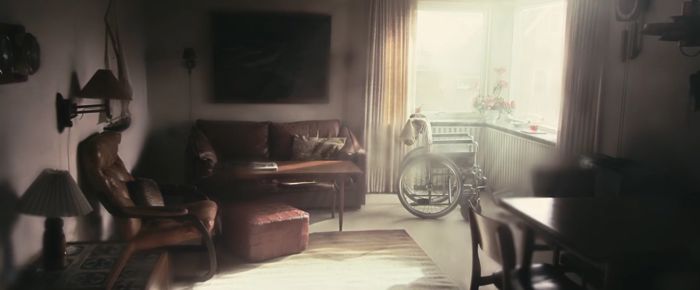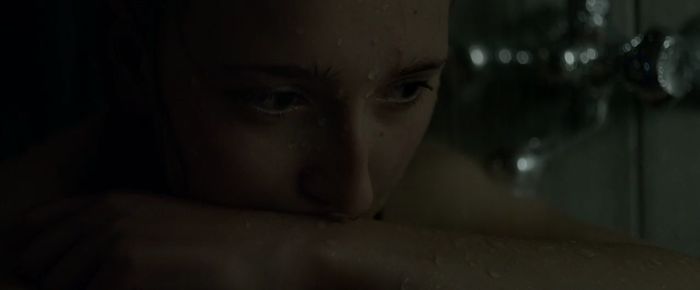The other night, I watched a double-feature of two new horror movies featuring ladies as monsters: When Animals Dream, a Danish movie about a young girl who discovers that she is a werewolf, and A Girl Walks Home Alone At Night, an black-and-white American movie filmed in California, set in Iran (and with dialogue in Persian), about a woman who is a vampire. They were both very good. Today, I’ll talk about the former, and tomorrow, the latter. Let’s get into it.

When Animals Dream starts off with a series of beautiful clouded vignettes featuring remote Danish locations and no people, over which the opening credits are shown. They’re beautiful and strange, showcasing a tiny nameless Danish fishing village. Odd living-room tableaux. Darkened moors, a small lantern bobbing in the distance. Fields of scrubland, sparse clumps of vegetation. Tiny houses set off on dirt roads, featureless expanses beyond to the horizon.

It’s a beautiful introduction to the strange world in which this movie takes place, glowing and cinematic and slow, before we even meet any of the characters.
The main character of When Animals Dream is Marie. She’s a late-teens girl living with her father and her mother, who is nonverbal and wheelchair-bound. We see her feeding her mother, and we see her father bathing her mother and periodically giving her injections. Marie gets a job at a fish cleaning and packing warehouse, where things quickly start to get a little rough.
The basic outlay of this movie is fairly well-trodden territory: it’s the story of Carrie. A young girl faces societal pressures, which build until those pressures unleash something hidden within her. It’s a revenge movie, basically, which takes all of the pressure off of the plotting, and allows for the visuals, pacing, and acting to really take center stage.
Once Marie starts working at the fish packery, her co-workers start to haze her. They push her into a pond full of rotting and fetid fish heads and skeletons.

When she’s hauled out by the foreman, she gets a round of applause from all of her co-workers, giving the sense that this is a mandatory rite of passage for all employees of the plant; but then the hazing continues in a much more unpleasant manner, that leaves no doubt that she’s been targeted for ongoing abuse.
Meanwhile, she discovers a small rash on her chest. She sees the doctor, who tells her to let him know if it spreads or gets worse. It starts to (very quickly) sprout a thicket of hair, which she shaves off with a small pink disposable razor. Her eyes start to do this weird thing:

When I was watching this movie, I kept thinking about the Jezebel review of the Carrie remake, bemoaning the casting of Chloe Grace Moretz (who is a wonderful actress, but too beautiful to play outcast Carrie White) and referring to Sissy Spacek as an “actual feral prairie ghost.” Sonia Suhl is the Danish equivalent of that actual feral prairie ghost, all angular features, wide-eyed timidity, and grasping, vulnerable loneliness.

Eventually, Marie begins to understand that her mother is feared and reviled by the members of the village community, and that the injections she receives are designed to keep her sedated and near-comatose. After sprouting more hair, Marie is confronted by her father and her doctor, who attempt to give her an injection.
I’m loath to give more away here, because the way it unfolds is satisfying and fascinating. I’ll keep going with the screenshots, and discuss the movie in more general terms.
These days, a lot more horror movies seem to have no problem taking their time, which is a development that I absolutely love. After an inundation of movies that leap straight to the horror (I’m looking at you, Saw), it’s nice to see a return to the slow introduction. I’ve always been a firm believer in the Stephen King adage that horror doesn’t really work unless the audience actually cares about the characters. Hack’n’slash movies have their place, but they function more as gruesome spectacle, and rarely inspire actual horror. Here’s a quote from King’s Danse Macabre that has stuck with me from a young age:
I recognize terror as the finest emotion and so I will try to terrorize the reader. But if I find that I cannot terrify, I will try to horrify, and if I find that I cannot horrify, I’ll go for the gross-out. I’m not proud.
As a clarification: terror is the emotion leading up to a horrible occurrence– that sense of dread, anxiety, and impending doom. Horror is the mixture of empathetic fear and nauseous disgust that happens after the horrible occurrence.

This movie deals primarily in terror. You can see the impending crash of awfulness, but first-time director Jonas Alexander Arnby somehow dodges expectations, and the actual moments of shock and awfulness often come out of left field– and then they end up piling back onto the inevitable stack of dread, allowing that anxiety and dread to continue.
When hell finally breaks loose, it’s almost a relief.
Actual Danish tidal-pool ghost Sonia Suhl, who plays Marie, really shines throughout, and continues her incredible performance once she sheds her humanity and becomes a werewolf. There’s no longer even any hint of personhood there, and Marie really becomes an animal, an exemplification of revenge, and the explosive, inevitable violence of cornered ferocity.

And then, the aftermath: a mirroring of the beginning. A series of tableaux, this time of the aftermath.

This movie is beautiful and strange and striking. I recommend it.
